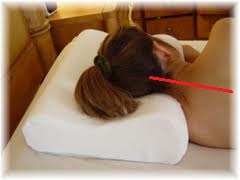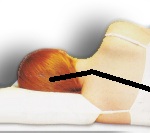Pillows For Neck Pain
Trying to get a good night's sleep when you have neck pain can be frustrating. Finding the best pillow for neck pain may be able to minimize the discomfort you feel during the night, so it pays to carefully shop for the right one for your needs.
There are lots of options. Here are some things to think about when you are ready to make your next purchase.
Pillows For Side-Sleepers
Finding a good pillow for side sleepers is a bit tricky because there is a lot of variation in the thickness that people need. Let's look first at how to determine what thickness is best for you.
You'll want to find a pillow that fills the space between your bed surface and the side of your neck, but it shouldn't push your head up toward the ceiling. It also shouldn't be so thin that your head drops toward the bed.
Keeping your neck in a straight and neutral position is the key to real comfort.
If you have a partner or friend who can help you experiment with your pillow thickness, that's great. Set yourself up with the pillow you like best and have them look at you from the back. The pillow should completely fill the void between your shoulder and neck. The center of your head and your spine should be in a straight line. If they are aligned, you've hit pillow gold. This configuration should provide you with a good night's rest.
Balanced Head Position on a Pillow

- Thickness matches the width of the shoulders.
- Head and neck maintain correct alignment with the spine.
- Fully fills the space around the neck and shoulder.
Collapsed Shoulder

- Too thin and does not support the neck and head.
- Shoulder collapses due to lack of support.
- Head tilts down which compresses muscles at the side of the neck.
Head Tilts Down on the Pillow

- Too thin for this person's body.
- Support is lacking in the space between the neck and shoulder.
- The head is forced down, aggravating the muscles at the side of the neck.
Too Much Support

- The support here is too thick for this person's body.
- Thickness at the top of her head forces her head towards the ceiling.
- There is too little support under her neck, encouraging collapsed shoulders and compression of the muscles at the side of the neck.
Do You Sleep On Your Back?
Back sleepers need enough support under their necks to fully cradle the neck, but not so much that it forces your head and neck forward, or tilts your head into a chin-down position. The thing to look for is support that makes contact with your entire neck, feels comfortable to rest on, and allows your head, neck and shoulders to remain in a neutral position.
In general, a thinner thickness is most appropriate for people who sleep on their back. This helps keep your head and neck in a more neutral position as you sleep. The stuffing material should be cushy but firm. You don't want it to collapse under you as you sleep, so very loose and fluffy stuffing may not be the greatest choice for you.
If You Sleep On Your Stomach
You've probably heard this before from your doctor or chiropractor, but sleeping on your stomach is not the best idea for people with neck pain. This position forces you to turn your head all the way to the side which will put all the muscles in your neck under a lot of stress. Still, for some people stomach sleeping is their preferred position, so let's talk about finding the right kind of support that will help minimize the stress to your neck.
Once again, the size of your body plays a big role in finding the best head and neck support for your needs. Are you slim? If so, then you need thinner support. Are you not so slim? The thickness needs to increase with the size of your body.
Look for a pillow that has softer sides that have some "give". If you must sleep on your stomach, you'll find it more comfortable to only partially turn your head to the side. So, resting your head on the pillow's edge will support the weight of your head and still allow your nose to drop towards the bed. In this position, your head is turned partially. This is a much less stressful position for your neck muscles.
Do You Sleep In All Positions?
Sometimes people toss and turn because they can't find a position in which they are really comfortable. I believe that if you can find the best support for your neck pain, you will toss and turn less. It might be possible to find a pillow that really works for all sleeping positions, but I haven't found it yet. My choice has always been to find one that meets most of my needs, and that's what I'd suggest you do too.
Tips From Sharon
 |
When was the last time you washed your pillows? Click HERE to find out how! |
What Should The Pillow Filling Be?
I've experimented for years with different kinds of pillows for neck pain and proper neck alignment. Most of them have been thrown away because they simply did not work for me. You may also have to experiment before you find the best choice for your body and sleeping style, so don't get discouraged if the first few don't meet your standards.
Natural Pillow Filling Materials
Down or Feathers
Down or feather pillows feel very luxurious but I have not found them to be great for neck pain. They tend to be very pliable, so it's possible to play with the filling to create support, but it tends to be inconsistent support. You'll feel hills and valleys and what you need is consistent support no matter how you position your body.
The other problem with down or feathers is that the material is mostly air. Because of this, you end up with no support under your neck as the feathers compress throughout the night while holding up the weight of your head. This leads to less control over your posture as you sleep.
If you really, really like the feel of down or feathers, then look for a foam core that is wrapped in down. This will give you the feel of down, but the consistent support of a firmer, less adjustable center.
Pillows Filled With Seeds (Or Other Small Pellets)
A new trend is to use a pillow filled with seeds, seed husks, or small pellets of some kind. This is a great idea, in theory, but the experience during sleep can be too firm. It's also possible for the seeds to shift as you move during the night which can affect how much support you get.
Because of the firm feel of this kind of support, you can end up putting pressure on the muscles that hurt you the most. This can be very uncomfortable. Still, some people really like the firm feel so in that case it would be worth it to give one of them a try. After all, George Washington slept on a block of wood. What's the harm in a few seeds?
Cotton or Wool Filled Pillows
I must admit that I have not tried any of these. My guess is that they will provide at least as much support as poly-fill. If the material inside is in clumps or tufts, then the feel should be pretty adjustable and supportive.
The best thing about filling made with these natural materials is that they will not have any chemical smell or off-gassing associated with them. This makes them a great choice for people with chemical sensitivities. Be sure to check the label to see if they are washable. Anyone who has an allergy or other sensitivity will find this very important.
Manmade Materials for Pillows
Polyester Fiberfill Pillows
Polyester fiberfill seems to appear in pillows in two ways. It can come in sheets, like quilt batting, or it can be in small clumps or tufts. Let's take a look at both.
If the inside feels like it is one solid piece of material, then it is made with polyester sheets of fiberfill. You can usually choose the firmness you would like. The firmness will be consistent throughout which will decrease the amount of control you have over the support and contouring that you might want.
Clumps or tufts of polyester will feel a little lumpy but that usually doesn't affect your sleeping comfort. You can squish them around in various ways which can make them a little more customizable to your needs. Again, you can usually choose the level of firmness you want so look carefully on the labels for this information.
Poly fill can usually be machine washed and dried. Be sure to check the label for its care instructions.
Foam Filled Pillows
Just like poly-filled, foam filled pillows come in two types of fill - solid foam and foam pieces.
Solid foam can be one consistent density of foam, or they can be manufactured with layers of varying density foam. Each of these is interesting to try.
Solid foam fill can also be found with a convoluted surface, like an egg crate. Some people like this kind of support which can also come in varying levels of firmness. You'll have to experiment to see if you like this style of fill. Fortunately, they are usually not too expensive.
Foam pieces feel lumpy to the touch, but the fact that the filling is in small pieces makes these pillows more adjustable to your needs. Again, you can usually find varying levels of support and thickness.
Memory Foam Pillows
Memory foam pillows are usually found in a contour shape, sort of like a single wave (See the top photo for an example). Most of them have one side that is slightly higher than the other side, with the thinnest part in the middle.
The unique shape allows you to choose the side that gives you the best support for your body size and style of sleeping. These are best for people who sleep on their sides.
I like this one best because the support is very consistent and it changes and continues to mold itself to my head and neck as I move. The material feels supportive, but gentle on sore pressure points.
The memory foam itself is not washable, but the fabric covering is. It is my understanding that this kind of fill will not attract dust mites which can be a real comfort for people with dust allergies.
How Long Should You Keep Your Pillow?
Pillows are filled with materials that can attract dust, dust mites, bacteria and germs. The filling can also become less supportive over time. It makes sense, therefore, to replace your pillows periodically to avoid allergic reactions and to maintain proper support.
Here's an interesting article from Dr. Mercola that gives excellent guidelines for keeping and maintaining the healthiness and support from your pillows.
How Long Should I Keep My Pillow?
Click the block below that most closely matches your injury for more information and to find the Toolkit we offer to help you in your recovery.







